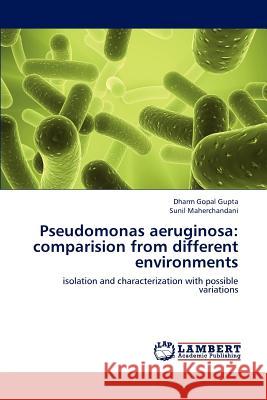Pseudomonas Aeruginosa: Comparision from Different Environments » książka
Pseudomonas Aeruginosa: Comparision from Different Environments
ISBN-13: 9783659313301 / Angielski / Miękka / 2013 / 156 str.
Pseudomonas aeruginosa is a ubiquitous highly versatile and the second most important opportunistic pathogen which causes variety of infections in humans as well as in animals. Out of 296 samples processed in the present investigation, 64 P. aeruginosa isolates were obtained from clinical, non-clinical and environmental sources. Upon phenotypic analysis, Most of the isolates gave comparable results except for aesculin hydrolysis (positive for 50% of the environmental that too soil isolates) and for rhamnolipid production (negative for 50% of clinical isolates). Upon resistotyping, Polymyxin was found to be 100 per cent effective antibiotic followed by carbanicillin (95.31%), imepenem and tobramycin (92.19%), ofloxacin (89.06%), gentamicin and ciprofloxacin (85.94%), colistin (82.81%) and amikacin (76.56%). Among the three groups environmental isolates were found to be more resistant to aminoglycosides, cephotaxime and colistin than the nonclinical and clnical isolates. upon genotyping, 61 (95.31%) isolates could be typed as Pseudomonas with 16S rRNA based genus specific primers and 43 (67.18%) isolates could be typed as P. aeruginosa with 16S rRNA based species specific primers
Pseudomonas aeruginosa is a ubiquitous highly versatile and the second most important opportunistic pathogen which causes variety of infections in humans as well as in animals. Out of 296 samples processed in the present investigation, 64 P. aeruginosa isolates were obtained from clinical, non-clinical and environmental sources. Upon phenotypic analysis, Most of the isolates gave comparable results except for aesculin hydrolysis (positive for 50% of the environmental that too soil isolates) and for rhamnolipid production (negative for 50% of clinical isolates). Upon resistotyping, Polymyxin was found to be 100 per cent effective antibiotic followed by carbanicillin (95.31%), imepenem and tobramycin (92.19%), ofloxacin (89.06%), gentamicin and ciprofloxacin (85.94%), colistin (82.81%) and amikacin (76.56%). Among the three groups environmental isolates were found to be more resistant to aminoglycosides, cephotaxime and colistin than the nonclinical and clnical isolates. upon genotyping, 61 (95.31%) isolates could be typed as Pseudomonas with 16S rRNA based genus specific primers and 43 (67.18%) isolates could be typed as P. aeruginosa with 16S rRNA based species specific primers











